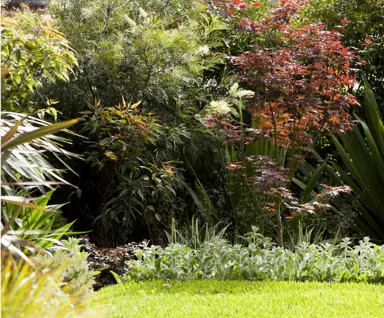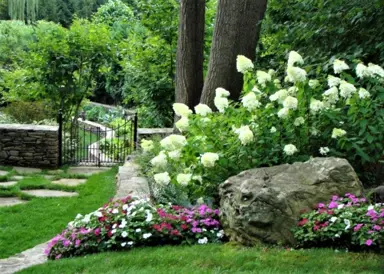Bird Of Paradise Caesalpinia gilliesii Information
Caesalpinia gilliesii is not related to the Strelitzia varieties, but shares the same common name. Some of the key characteristics of Caesalpinia gilliesii include:
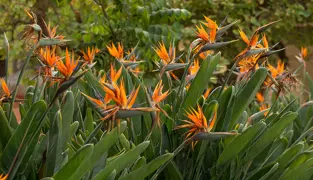
Bird of Paradise (Strelitzia spp.) is a striking plant known for its vibrant, bird-like flowers and lush foliage. Native to South Africa, it thrives in New Zealand's climate, bringing a tropical flair to gardens and indoor spaces. This guide covers everything from care and propagation to choosing the right variety for your space.
Choosing a Bird Of Paradise plant that works for you can be challenging. The Plant Company’s series of short articles aims to offer concise and easy to follow advice and recommendations so you can determine the variety for your needs.

Caesalpinia gilliesii is not related to the Strelitzia varieties, but shares the same common name. Some of the key characteristics of Caesalpinia gilliesii include:
With its vibrant flowers and attractive foliage, Caesalpinia gilliesii can be a beautiful addition to a garden.
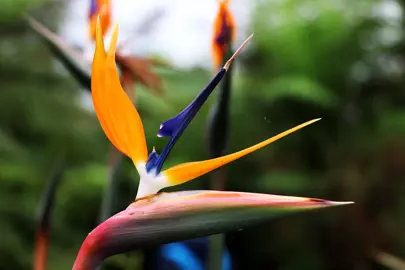
The Bird of Paradise flower, most commonly referring to Strelitzia reginae, is a stunning evergreen perennial native to South Africa. It's widely cultivated around the world for its dramatic and exotic flowers. A summary of the key characteristics include:
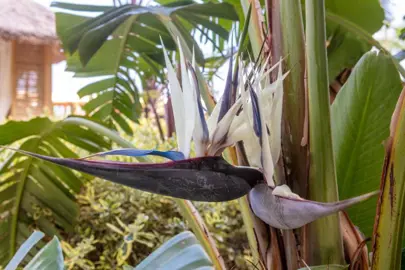
The Giant Bird of Paradise, also known as the Strelitzia nicolai, is a truly magnificent plant that brings a tropical flair to a space. Here are some details about this architectural wonder:

Strelitzia augusta, commonly known as the White Bird of Paradise, is a perennial plant native to the Eastern Cape region of South Africa. It's a truly magnificent plant with large white flowers that emerge from boat-shaped, purple bracts. The flowers are quite unique and resemble the head of a crane, hence the common name Bird of Paradise. Some of its key characteristics include:
Strelitzia augusta is a relatively fast-growing plant that can thrive in both containers and gardens in warm climates. However, it's not frost-tolerant and needs to be protected from freezing temperatures.

Strelitzia nicolai, also known as the Wild Banana or Giant White Bird of Paradise, is a truly magnificent plant that brings a touch of the tropics indoors and out. Some of its key characteristics include:
Strelitzia nicolai is a stunning plant that adds a touch of the exotic to any space. With its impressive size and architectural form, it is well suited to a host of landscape designs.
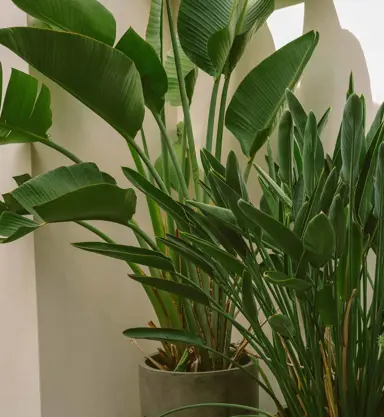
Some of the key differences between Strelitzia Nicolai (Giant Bird of Paradise) and Strelitzia reginae (Bird of Paradise flower):
Size:
Leaves:
Flowers:
Cold tolerance:
Overall:

Strelitzia parvifolia, also known as the Spoon-leaved Bird of Paradise or Miniature Bird of Paradise, is a close relative of the more well-known Strelitzia reginae (Orange Bird of Paradise). It shares the stunning bird-like flowers but in a more compact and manageable size. Some of its key characteristics include:
Strelitzia parvifolia is a beautiful and manageable Bird of Paradise option for those with limited space or cooler climates. With proper care and winter protection if needed, it can be a rewarding addition to your garden or patio.

Strelitzia reginae, commonly known as the Bird of Paradise or Crane Flower, is a species of flowering plant native to the Cape Provinces and KwaZulu-Natal in South Africa. It is a stunning evergreen perennial widely grown for its dramatic flowers. A summary of the key characteristics include:
Strelitzia reginae is a relatively low-maintenance plant that can thrive in both containers and gardens in warm climates. It makes a beautiful addition where ever it is grown.
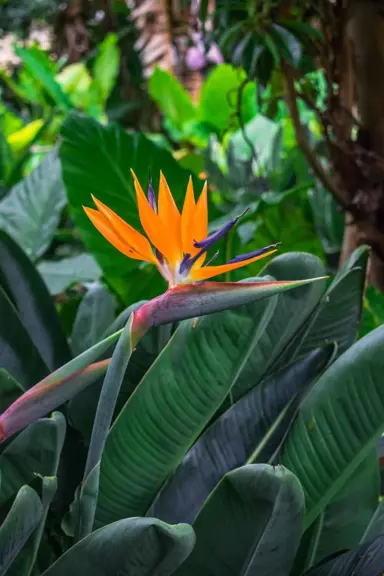
The following Bird of Paradise plants are generally available in NZ:
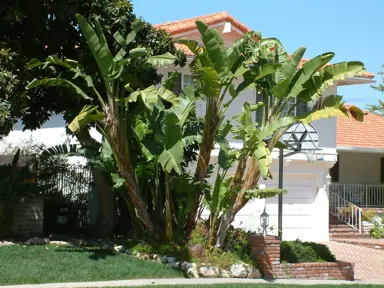
The tallest Bird Of Paradise species is Strelitzia Nicolai, commonly known as the giant white bird of paradise or wild banana. It can reach a height of up to 10 meters (33 feet) with an erect woody stem. Its large, banana-like leaves can grow up to 200 cm (6 feet) long and 80 cm (3 feet) wide. The flowers are produced in a horizontal inflorescence emerging from a stout spathe and are white with blue tips.

There are two main contenders for the title of "White Bird of Paradise" plant; Strelitzia Nicolai and Strelitzia alba.
Caring for Bird Of Paradise plants is about making sure they are thriving. Our plant care articles provide the necessary details to give you the greatest chance of success. Afterall, there is nothing worse than investing in the plants, putting the effort into planting them, and then having them fail. Therefore, follow our advice and give yourself the best chance of success.
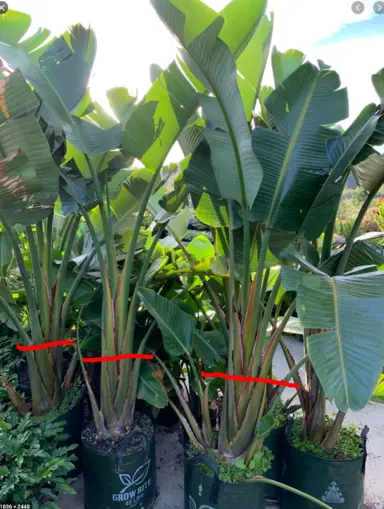
Giant White Bird Of Paradise plants can be trimmed to control their size and maintain their shape. The best time to trim them is in late winter or early spring. This is when the plant is dormant and less stressed by pruning. You can remove dead, diseased, or damaged leaves at any time. For healthy leaves, focus on removing the older, lower leaves. This will help improve air circulation and make the plant look tidier. Once the flowers have faded, you can cut off the flower stalks at the base where they emerge from the main stem. If your plant is getting too tall for your space, you can take more drastic measures. Remove stems or cut them back to the desired height. More shoots will come away from the base of cut stems. These can be thinned out as necessary.
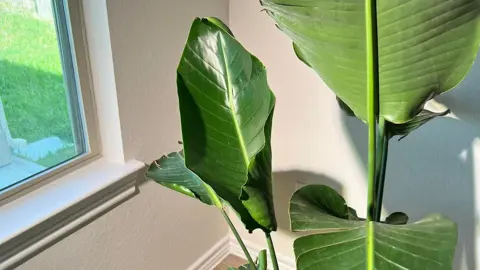
A few things can go wrong with a Bird Of Paradise plant and often we find it is human error than anything else that causes a plant to fail. The most common issues are presented below and organised from most likely to least likely based on The Plant Company's experience.

Bird of Paradise plants are generally low-maintenance and relatively free of problems, but they can occasionally experience issues due to various factors. Some common problems and solutions include:
In general, Bird of Paradise plants are easy to care for and thrive with proper attention to their watering, light, and nutrient needs. By addressing any problems promptly, you can keep your bird of paradise plant healthy and enjoying its striking foliage and exotic flowers.
Bird Of Paradise propagation is a relatively straightforward process when you have the right advice. Our articles give you the best chance of doing this successfully and efficiently.
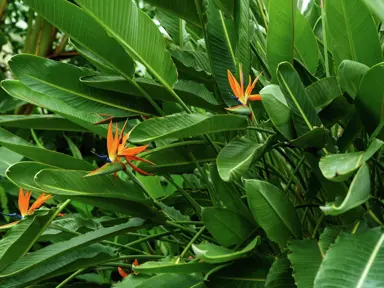
Yes, you can divide Bird Of Paradise plants! It's actually the most common and recommended way for home gardeners to propagate them. It also helps create new and healthy plants and is a great way to rejuvenates overgrown or root-bound plants.
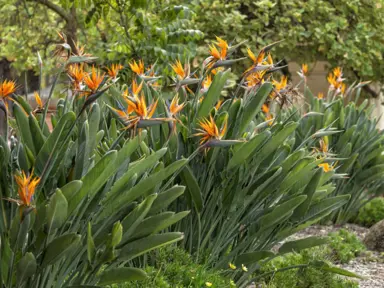
Unfortunately, propagating Bird Of Paradise plants from stem or leaf cuttings is not possible. These plants lack the necessary growth nodes on their stems and leaves to develop roots independently. Rather, they are propagated by dividing mature clumps into several plants.
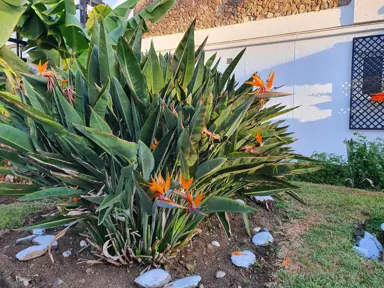
Bird of Paradise plants are propagated by two main methods:
Planting a Bird Of Paradise and getting it to grow well is generally easy when you get a few of the basics right. This involves planting them in the right soil type, choosing the most ideal planting position, selecting the best variety, and ensuring the plants have the essentials to thrive. The Plant Company has the right advice to give you the greatest chance of success when growing a Bird Of Paradise.

Both Strelitzia Nicolai (Giant Bird of Paradise) and Strelitzia reginae (Bird of Paradise flower), can be grown indoors in New Zealand. They are popular choices for their exotic flair and beautiful foliage. Some things to keep in mind:
Bird of paradise plants are generally slow growers, so be patient. Also note that they are unlikely to flower when grown indoors, though they will reward you with lush foliage.
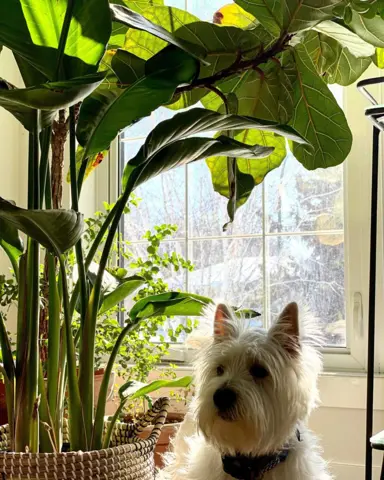
Bird of Paradise plants are considered minimally toxic to humans. This means that a small, accidental ingestion likely won't cause any problems for an adult. However, for small children and pets, ingestion of any part of the plant can cause mild stomach upset, vomiting, or diarrhoea. The sap can also irritate skin, so it's always best to wear gloves when handling the plant.

Bird of Paradise plants do not need high humidity or any misting to grow well. Normal humidity levels in a house are generally fine.
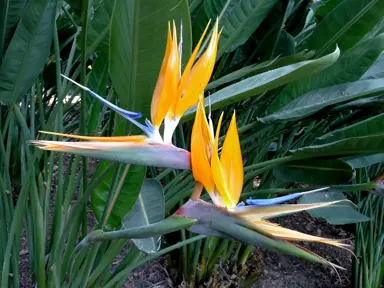
The general rule for watering Bird of Paradise plants is once every week during spring and autumn, twice a week during summer, and once a fortnight during winter. Ideally, you’ll wait for the top 10-20 mm of soil to be completely dry before watering. The Plant Company does a deep-watering each time. That is, water until water runs out the bottom of the pot.

Strelitzia reginae, commonly known as the Bird of Paradise, grows well in New Zealand, but there are a few things to keep in mind:
With careful selection of the planting location and winter protection in colder regions, Strelitzia reginae can be a beautiful and rewarding addition to a New Zealand garden.
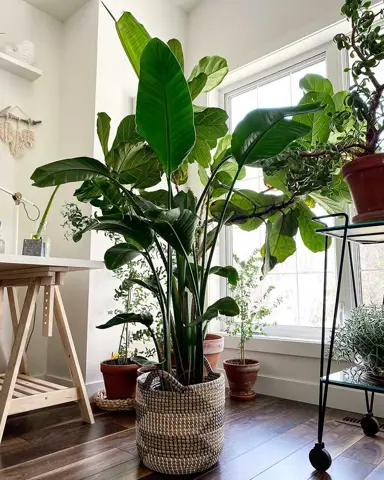
The Giant Bird Of Paradise (Strelitzia Nicolai) is considered a moderate grower. Expect around 60 cm (2 feet) of height increase per year. It can take several years to reach maturity which is typically after 7-10 years. It may take 4-5 years for a young plant to produce its first flower.

Bird of Paradise plants thrive in bright, indirect light when grown indoors. They will also grow well in full sun. They tend to grow poorly in shaded positions.
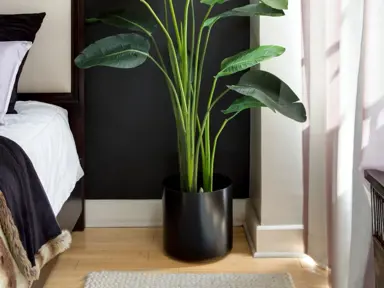
Bird Of Paradise plants look amazing when managed appropriately in a pot indoors. Choose a pot that is no more than twice the size of what the plant is currently growing in and that has plenty of drainage holes in the bottom. Fill the bottom of the pot to about 1/3 of the way up with potting mix. Do not use soil or compost when growing plants in a container and do not add fertiliser. The Plant Company potting mix has all the nutrients required to sustain the plant for the next 12 months.
Remove the plant from the container it is growing in by either pulling it free or by cutting the bag. We recommend cutting the bag or container, especially for larger grade plants, to minimise any chance of damaging the roots. If the roots have been growing in a circle or are all bound up you can tease them apart if you want but this is not essential. Similarly, you don’t need to remove any of the growing media. The Plant Company does not recommend cutting the roots, even if the plant is root-bound as this offers no benefit. This is explained in our article, Managing Rootbound Plants. Add more potting mix and firm this around the plant using gentle pressure, then water well. They should be watered twice a week during hot weather and weekly or fortnightly during cooler periods.
The key to having an amazing Bird Of Paradise in a pot is to water it when the top 25 mm of soil is dry, keep it away from cold drafts, and feed it with indoor plant fertiliser in spring and again in autumn.
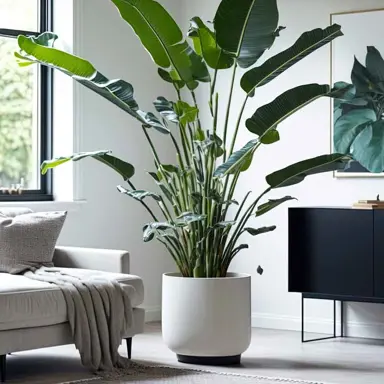
Bird of paradise plants can thrive indoors with the right care. There are a few things to get right so they perform well.
Bird of paradise plants are generally slow growers, so be patient. Also note that they are unlikely to flower when grown indoors, though they will reward you with lush foliage.

There isn't a guaranteed way to stunt a bird of paradise plant's growth entirely, but some techniques can slow the growth down:

Choose a full sun position with good drainage and moderate shelter for your Bird Of Paradise plant. The hole should be dug to at least 50-75% deeper and wider than the container the plant is currently growing in. A good planting spade makes this job a lot easier. The Plant Company recommends incorporating compost or sheep pellets into the soil to provide additional organic material, but this is not essential. Do not put fertiliser in the bottom of the hole, rather spread that on the soil surface after planting, and preferably do this when the plant is actively growing in spring.
Remove the plant from the container it is growing in by either pulling it free or by cutting the bag. We recommend cutting the bag, especially for larger grade plants, to minimise any chance of damaging the roots. If the roots are bound up, you can tease them apart if you want but this is not essential. The Plant Company does not advise cutting through roots, even if the plant is rootbound, as that injures the plant. Our article, Managing Rootbound Plants explains this in more detail.
Now place the plant in the hole and make sure it is level with the soil surface before filling in around it. If it is sitting above the soil surface, dig more out. If it is below, put in more soil and retest the level. Once the plant is set level with the soil surface, add more soil gradually and firm it around the plant using gentle pressure from your fingers as you go. Scatter garden fertiliser across the soil surface after planting and the give the plant a good watering. If the plant is taller than 30 cm you might want to consider staking it to give it a bit of extra support and use tree ties for secure and appropriate holding.

To repot a Bird of Paradise plant, start by removing the plant from the container it is growing in by either pulling it free or by cutting the bag. The Plant Company recommends cutting the bag or container, especially for larger grade plants, to minimise any chance of damaging the roots. If the roots have been growing in a circle or are all bound up you can tease them apart if you want but this is not essential. Similarly, you don’t need to remove any of the growing media. The Plant Company does not recommend cutting the roots, even if the plant is root-bound as this offers no benefit. This is explained in our article, Managing Rootbound Plants.
Choose a pot that is no more than twice the size of what the plant is currently growing in and that has plenty of drainage holes in the bottom. Fill the bottom of the pot to about 1/3 of the way up with potting mix. Do not use soil or compost when growing plants in a container and do not add fertiliser. The Plant Company potting mix has all the nutrients required to sustain the plant for the next 12 months. Place the plant in the pot and add more potting mix. Firm this around the plant using gentle pressure, then water well. They should be watered twice a week during hot weather and weekly or fortnightly during cooler periods.
The key to having an amazing Bird Of Paradise in a pot is to water it when the top 25 mm of soil is dry, keep it away from cold drafts, and feed it with indoor plant fertiliser in spring and again in autumn.

Strelitzia reginae (Orange Bird of Paradise) has some frost tolerance but can be damaged by freezing temperatures. Severe or prolonged frosts will damage the foliage and flowers. The roots might survive short freezes if the soil doesn't freeze completely, but the plant may not flower the next season due to the significant damage to the foliage. Frost cloth is a good option to protect vulnerable plants.

Bird of Paradise plants prefer temperatures in the range of 18°C-30°C (65°F-85°F). The most critical element is to not let the temperature drop below 15°C (60°F) as this can cause chilling injury.
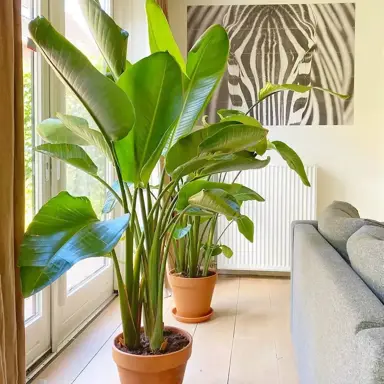
A full sun or partial shade position with good drainage is essential for getting the best results with Bird Of Paradise plant. On poorly drained sites, or with over-watering, they tend to become stunted and sickly looking due to the roots struggling to breathe. As shade levels increase, they tend to become spindly and flowering is often reduced or does not occur. In full sun positions they tend to grow more compactly. The position should also be moderately sheltered so leaves are not broken by wind and this will help produce a better shaped plant overall. Some Bird Of Paradise plants can take a light frost once established, but it pays to seek local advice on this one. Wherever they are grown, make sure that they will not dry out during summer and they have plenty of room to expand.
Enjoy free shipping on orders over $150 along with fast delivery of high-quality plants.
Whether you need assistance finding the plant you’re looking for or you simply want to know more about who we are and what we do, we invite you to get in touch with us today. A member of The Plant Company team will get back in touch as soon as possible.

